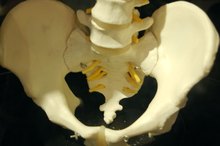Causes of Pain in the Lower Right Quadrant
Pain in the right lower quadrant -- the lower right area of the abdomen -- can arise from a variety of causes. These underlying causes range in severity from minor to potentially life-threatening, possibly requiring emergency surgery. The right lower quadrant contains organs from the digestive, urinary and reproductive systems, along with blood vessels, nerves and other tissues. Abnormalities in any of these organs, structures and tissues can cause pain in the right lower quadrant (RLQ).
If you are experiencing serious medical symptoms, seek emergency treatment immediately.
Digestive System
Digestive system organ abnormalities are the most common cause of RLQ pain. Appendicitis -- swelling and inflammation of the appendix -- heads the list of possible digestive system causes 2. Diverticulitis, which is inflammation or infection of small pouches along the large intestine, is another possible cause of RLQ pain. Other possible causes include colon cancer and inflammatory bowel disease, including Crohn disease and ulcerative colitis. Meckel diverticulum, an outpouching of the lower intestine, can lead to RLQ pain as well.
- Digestive system organ abnormalities are the most common cause of RLQ pain.
Urinary System
Causes of Lower Left-Side Abdominal Pain
Learn More
The urinary system includes the kidneys, ureters and bladder. The right ureter -- the tube through which urine flows from the kidney to the bladder -- passes through the RLQ. Kidney stones may lodge anywhere along the ureter, typically causing intense pain that often radiates to the back. Urinary tract infections can also cause:
- pain in this area
- especially if the infection migrates from the bladder to the kidney [3](# 'inline-reference::Advanced Health Assessment
- Clinical Diagnosis in Primary Care
- 4th Edition; Joyce E
Dains
Dr.P.H.
et al.'). Large tumors and cysts of the urinary system are other possible culprits for RLQ pain. They may be noncancerous, as in polycystic kidney disease, or cancerous, as in kidney or bladder cancer.
- The urinary system includes the kidneys, ureters and bladder.
- Urinary tract infections can also cause: * pain in this area
* especially if the infection migrates from the bladder to the kidney [3](# 'inline-reference::Advanced Health Assessment
* Clinical Diagnosis in Primary Care
* 4th Edition; Joyce E Dains
* Dr.
Female Reproductive System
In women, RLQ pain frequently arises from the reproductive system organs, including the uterus, fallopian tubes and ovaries. Ovarian cysts can become twisted or rupture, causing pain. Ectopic pregnancy -- a pregnancy that implants outside the uterus -- causes pain as it grows. If not treated, an ectopic pregnancy may rupture and cause severe pain and life-threatening bleeding. Pelvic inflammatory disease (PID), a bacterial infection of the female reproductive organs, can cause lower abdominal pain as well. Untreated PID can lead to formation of an abscess -- a collection of infected fluid or pus -- with worsening pain. Endometriosis is a painful condition that occurs when cells from the uterine lining grow in various places within the pelvis. ').
- In women, RLQ pain frequently arises from the reproductive system organs, including the uterus, fallopian tubes and ovaries.
- Untreated PID can lead to formation of an abscess -- a collection of infected fluid or pus -- with worsening pain.
Musculoskeletal System
Lower Stomach & Groin Pain
Learn More
The musculoskeletal system consists of the body's muscles, tendons, ligaments, bones and other connective tissue. RLQ pain may develop from strained muscles after a person engages in vigorous physical activity. The bones of the spine, known as vertebrae, have soft discs between them for cushioning. If these discs bulge and impinge on a nerve, they can trigger pain in the area that the nerve serves. A right-sided hernia -- a condition in which a portion of the bowel protrudes through a defect in the abdominal wall muscles -- may cause fluctuating RLQ pain or severe, constant pain.
- The musculoskeletal system consists of the body's muscles, tendons, ligaments, bones and other connective tissue.
- A right-sided hernia -- a condition in which a portion of the bowel protrudes through a defect in the abdominal wall muscles -- may cause fluctuating RLQ pain or severe, constant pain.
Cardiovascular System
The cardiovascular system includes the heart, arteries and veins. The body's largest artery, the aorta, courses through the abdomen and splits into two arteries, the common iliac arteries. An aortic aneurysm -- ballooning or enlargement of the aorta -- can lead to RLQ pain. The pain is caused by blood leaking into the wall of the aorta or rupture of the enlarged segment. If the enlarged area extends from the lower aorta to include the right common iliac artery, this may cause pain in the RLQ. A blood clot or temporary decrease in blood supply to the intestinal segments in the RLQ can also cause pain in this area due to a reduction in oxygen delivery to the affected tissues.
- The cardiovascular system includes the heart, arteries and veins.
- If the enlarged area extends from the lower aorta to include the right common iliac artery, this may cause pain in the RLQ.
Warnings and Precautions
Pain in the RLQ accompanied by certain signs and symptoms could indicate a serious health problem 3. Signs and symptoms to watch that indicate a need to seek immediate medical attention include: -- severe or worsening abdominal pain -- fever -- inability to eat -- nausea and vomiting -- bloody or black stools -- blood in the urine -- dizziness, lightheadedness or fainting -- a rapid or pounding heartbeat -- extreme drowsiness and other sudden mental changes
Reviewed by: Tina M. St. John, M.D.
Related Articles
References
- Rosen's Emergency Medicine: Concepts and Clinical Practice, 8th Edition; John A. Marx, M.D., et al.
- Andreoli and Carpenter's Cecil Essentials of Medicine, 8th Edition; Thomas E. Andreoli, M.D., et al.
- Advanced Health Assessment and Clinical Diagnosis in Primary Care, 4th Edition; Joyce E. Dains, Dr.P.H., et al.
- American Cancer Society. (2016). Signs and Symptoms of Endometrial Cancer. https://www.cancer.org/cancer/endometrial-cancer/detection-diagnosis-staging/signs-and-symptoms.html
- American College of Obstetrics and Gynecology. (2011). Chronic Pelvic Pain. https://www.acog.org/Patients/FAQs/Chronic-Pelvic-Pain
- Kruszka PS, Kruszka SJ. Evaluation of acute pelvic pain in women. Am Fam Physician. 2010;82(2):141-7.
- Origoni M, Leone roberti maggiore U, Salvatore S, Candiani M. Neurobiological mechanisms of pelvic pain. Biomed Res Int. 2014;2014:903848. doi:10.1155/2014/903848
- Sivalingam VN, Duncan WC, Kirk E, Shephard LA, Horne AW. Diagnosis and management of ectopic pregnancy. J Fam Plann Reprod Health Care. 2011;37(4):231-40. doi:10.1136/jfprhc-2011-0073
- Das BB, Ronda J, Trent M. Pelvic inflammatory disease: improving awareness, prevention, and treatment. Infect Drug Resist. 2016;9:191-7. doi:10.2147/IDR.S91260
- Bloski T, Pierson R. Endometriosis and Chronic Pelvic Pain: Unraveling the Mystery Behind this Complex Condition. Nurs Womens Health. 2008;12(5):382-95. doi:10.1111/j.1751-486X.2008.00362.x
- Williams ARW. Uterine fibroids - what's new? F1000Res. 2017;6:2109. doi:10.12688/f1000research.12172.1
- Liu X, Song L, Wang J, Liu Q, Liu Y, Zhang X. Diagnostic utility of CT in differentiating between ruptured ovarian corpus luteal cyst and ruptured ectopic pregnancy with hemorrhage. J Ovarian Res. 2018;11(1):5. doi:10.1186/s13048-017-0374-8
- Cleveland Clinic. Mittelschmerz. 2015.
- Huang C, Hong MK, Ding DC. A review of ovary torsion. Ci Ji Yi Xue Za Zhi. 2017;29(3):143-147. doi:10.4103/tcmj.tcmj_55_17
- Devlin SM, Diehr PH, Andersen MR, Goff BA, Tyree PT, Lafferty WE. Identification of ovarian cancer symptoms in health insurance claims data. J Womens Health (Larchmt). 2010;19(3):381-9. doi:10.1089/jwh.2009.1550
- Pakish JB, Lu KH, Sun CC, et al. Endometrial Cancer Associated Symptoms: A Case-Control Study. J Womens Health (Larchmt). 2016;25(11):1187-1192. doi:10.1089/jwh.2015.5657
- Shapley M, Jordan J, Croft PR. A systematic review of postcoital bleeding and risk of cervical cancer. Br J Gen Pract. 2006;56(527):453-60.
- Louis MA, Doubleday AR, Lin E, Baek JY, Andoni A, Wang XH. Abdominal Pain in the Female Patient: A Case of Concurrent Acute Appendicitis and Ruptured Endometrioma. Case Rep Surg. 2016;2016:2156148. doi:10.1155/2016/2156148
- Choung RS, Herrick LM, Locke GR, Zinsmeister AR, Talley NJ. Irritable bowel syndrome and chronic pelvic pain: a population-based study. J Clin Gastroenterol. 2010;44(10):696-701. doi:10.1097/MCG.0b013e3181d7a368
- Faubion SS, Shuster LT, Bharucha AE. Recognition and management of nonrelaxing pelvic floor dysfunction. Mayo Clin Proc. 2012;87(2):187-93. doi:10.1016/j.mayocp.2011.09.004
- Collée G, Dijkmans BA, Vandenbroucke JP, Cats A. Iliac crest pain syndrome in low back pain: frequency and features. J Rheumatol. 1991;18(7):1064-7.
- Rowe TA, Juthani-mehta M. Diagnosis and management of urinary tract infection in older adults. Infect Dis Clin North Am. 2014;28(1):75-89. doi:10.1016/j.idc.2013.10.004
- Parmar MS. Kidney stones. BMJ. 2004;328(7453):1420-4. doi:10.1136/bmj.328.7453.1420
- Bernardi M, Lazzeri L, Perelli F, Reis FM, Petraglia F. Dysmenorrhea and related disorders. F1000Res. 2017;6:1645. doi:10.12688/f1000research.11682.1
- Bates CK, Carroll N, Potter J. The challenging pelvic examination. J Gen Intern Med. 2011;26(6):651-7. doi:10.1007/s11606-010-1610-8
- Hsu AL, Khachikyan I, Stratton P. Invasive and noninvasive methods for the diagnosis of endometriosis. Clin Obstet Gynecol. 2010;53(2):413-9. doi:10.1097/GRF.0b013e3181db7ce8
- Udoji MA, Ness TJ. New directions in the treatment of pelvic pain. Pain Manag. 2013;3(5):387-94. doi:10.2217/pmt.13.40
- American Cancer Society. (2016). Signs and Symptoms of Endometrial Cancer.
- American College of Obstetrics and Gynecology. (2011). Chronic Pelvic Pain.
- Faubion SS, Shuster LT, Bharucha. Recognition and Management of Nonrelaxing Pelvic Floor Dysfunction. Mayo Clin Proc. 2012 Feb;87(2):187-93.
- Kruszka PS, Kruszka SJ. Evaluation of Acute Pelvic Pain in Women. Am Fam Physician. 2010 Jul 15;82(2):141-47.
Writer Bio
Dr. Stephanie Vargas received her medical degree at the Indiana University School of Medicine and trained for two years as an emergency medicine physician. She is now a medical writer and uses her experience as a practicing physician to write about a variety of health topics.









